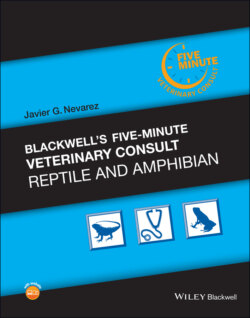Читать книгу Blackwell's Five-Minute Veterinary Consult: Reptile and Amphibian - Javier G. Nevarez - Страница 40
UVB REDUCTION
ОглавлениеAs previously mentioned, the type of material present between the bulb and the animal is an important consideration when selecting a UVB bulb. Most glass and plastics are known to block or filter out UVB radiation and are not recommended. The ideal scenario is one of an open‐topped enclosure with no material present between the bulb and the animal. While this is a possible application for chelonians, it is not feasible when housing snakes and some lizard species. A study by Burger et. al. revealed the UVB attenuating effects of common materials used in reptile enclosures and provides a sobering insight into the use of UVB bulbs (Burger et al, 2007).
The type of material, aperture of the openings, thickness, and reflective properties can all influence UVB attenuation and can significantly decrease the UVB exposure of reptiles. Most reptile enclosures have a screen or wire mesh top to keep the animals from escaping. Some of these screens may reduce the UVB light exposure to the animal by as much as 50%. To put this in perspective, if a reptile had a 10.0 linear fluorescent bulb, the effectiveness of that bulb might be reduced to that of a 5.0 by the time the light passes the screen and reaches the animal. This is why knowing the type of screen material is critical when selecting a bulb. A general recommendation is to select a screen with the largest aperture possible and with a mat or painted finish that will reflect less light.
